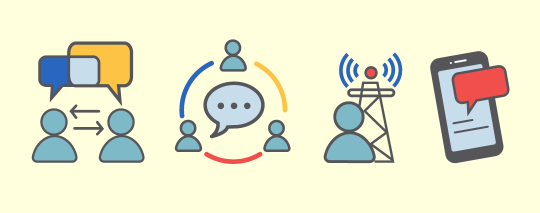Communication is at the center of everything we do. Every day, the words we say and actions we take convey messages, emotions, and information. What makes communication work (and not work) is something we don’t give much thought to, but did you know there is a scientific theory behind it? Read along to explore the communication process and tips to successfully communicate in the workplace.
What is communication theory?
Communication theory studies the process of sending and receiving information. Because there are so many methods, principles, and components that can affect a message and how it’s sent and received, communication theory aims to make sense of it all. Various features that can influence the process include the sender, receiver, noise, nonverbal cues, and cultural differences.
The basic elements of communication
The communication process is so complex, there’s no wonder there are so many different models trying to explain it. Some are linear and focus on one-way communication, while others are more circular and focus on two-way communication. Although each model differs, most contain similar elements.
- Source: What the sender is trying to communicate to the receiver.
- Message: The information being sent.
- Sender: The person sending the message, who encodes the source into a signal.
- Signal: What the sender sends to the receiver (written text, spoken word, etc.).
- Medium/Channel: Where the signal travels (via air, paper, internet, etc.).
- Noise: Any interference or distractions over the medium, which can disrupt the signal.
- Received Signal: What the receiver receives, which is potentially changed by noise.
- Receiver: The person who decodes the signal into the received message.
- Received Message: The information the receiver understands after decoding the received signal.
- Destination: The intended outcome of the communication.
When we put these elements together, communication works like this:
The sender needs to communicate something (source) to someone else (receiver). After encoding the source to a signal, the sender sends it via the medium. Between the time the message is sent and reaches its destination, interferences (noise) may distort the signal. The receiver picks up the received signal and decodes it in a way he or she understands, creating the received message, which has now arrived at its destination.
Successful communication at work
It’s easy to see how communication can get messy when there are interferences or differences in perception and understanding among the sender and receiver. Let’s take a look at an example of how communication can get distorted in an office setting.
- Source: Bob needs a sales report created and thinks Mary is the right person for the task.
- Message: Bob says, “Mary, can you please create a sales report for Wednesday?”
- Sender: Bob is the sender.
- Signal: Email with his message written in text.
- Medium/Channel: Bob sends the message via email.
- Noise: Corporate email and other traffic.
- Received Signal: Email message with text (potentially changed by noise).
- Receiver: The receiver is Mary.
- Received Message: “Mary, can you please create a sales report for next Wednesday?”
- Destination: Mary submits the report late because she thought the report was due on the wrong date (Bob didn’t specify which Wednesday).
In this scenario, the “noise” is Bob’s failure to be specific about which Wednesday the report was due, and Mary didn’t ask to clarify before starting the task.
For effective communication in the office (and in general), consider the factors that can influence a message between the time it leaves the sender and reaches the receiver, and check out these tips:
- Consider the channel preference of the person you’re trying to reach. Some may prefer phone calls while others like email and instant messaging.
- Be mindful of noise interference, especially if you’re speaking via phone.
- Be specific and emphasize details. If writing a message with multiple requests or parts, use bullets.
- If you’re the receiver, ask for clarification. If you’re the sender, ask for feedback. This can help reduce the chance of misunderstanding.





